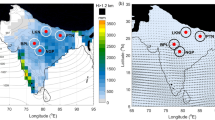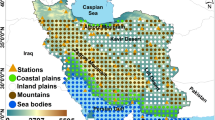Abstract
This study investigates the spatial and diurnal variation of storm height in the East Asia summer monsoon region using 13-year Tropical Rainfall Measuring Mission Precipitation Radar data. Precipitating storms are classified as shallow (<5 km), middle (5–10 km), and deep (>10 km) depending the height. Four different regimes are identified to characterize the region: the continental (CT) shallow regime over inland China with elevated terrain, the CT deep over the Chinese Plain, the coastal (CS) middle over the East China Sea and South Sea of Korea, and the CS shallow over the south coastal area of Japan. This regime separation reflects well the distinctive regional difference in the rainfall contribution by each storm type. The occurrence frequencies of shallow, middle, and deep storms exhibit pronounced diurnal variation as well, but with significant differences in the amplitude and phase across the regimes. These lead to a diversity in the diurnal variation of surface rainfall such as bimodal morning and late evening peaks in the two CT regimes and the single morning peak in the two CS regimes. Processes involved in the diurnal variation of storms are different across the regimes, indicating difference in the contributing role of surface heating, large-scale diurnal circulation, and diurnal propagations of convective systems. The storm height also affects the rain intensity. This study highlights that the East Asia summer monsoon has distinctive sub-regional variation of the storm height distribution, thereby providing unique differences in the rainfall amount, intensity, and the diurnal variation.
















Similar content being viewed by others
References
Asai T, Ke S, Kodama Y-M (1998) Diurnal variability of cloudiness over East Asia and western Pacific Ocean as revealed by GMS during the warm season. J Meteo Soc Jpn 76(5):675–684
Carbone RE, Tuttle JD, Ahijevych DA, Trier SB (2002) Inferences of predictability associated with warm season precipitation episodes. J Atmos Sci 59:2033–2056
Chang CP (2004) The East Asian monsoon. World Scientific, Singapore
Chen GTJ (2004) Research on the phenomena of Meiyu during the past quarter century: an overview. In: Chang CP (ed) The East Asian Monsoon. World Scientific, Singapore, pp 357–403
Chen S-J, Kuo Y-H, Wang W, Tao Z-Y, Cui B (1998) A modeling case study of heavy rainstorms along the Mei-yu front. Mon Wea Rev 126:2330–2351
Chen G, Sha W, Iwasaki T (2009) Diurnal variation of precipitation over southeastern China: spatial distribution and its seasonality. J Geophys Res 114:D13103
Chen G, Sha W, Iwasaki T, Ueno K (2012) Diurnal variation of rainfall in the Yangtze River Valley during the spring–summer transition from TRMM measurements. J Geophys Res 117:D06106
Chow KC, Chan JCL (2009) Diurnal variations of circulation and precipitation in the vicinity of the Tibetan Plateau in early summer. Clim Dyn 32:55–73
Fu R, Del Genio AD, Rossow WB (1994) Influence of ocean surface conditions on atmospheric vertical thermodynamic structure and deep convection. J Clim 7:1092–1108
Fujinami H, Nomura S, Yasunari T (2005) Characteristics of diurnal variations in convection and precipitation over the southern Tibetan Plateau during summer. SOLA 1:49–52
Ho CH, Park MS, Choi YS, Takayabu YN (2008) Relationship between intraseasonal oscillation and diurnal variation of summer rainfall over the South China Sea. Geophys Res Lett 35:L03701. doi:10.1029/2007GL031962
Houze RA, Wilton DC, Smull BF (2007) Monsoon convection in the Himalayan region as seen by the TRMM Precipitation Radar. Q J R Meteorol Soc 133:1389–1411
Huang WR, Chan JCL, Wang SY (2010) A planetary-scale land–sea breeze circulation in East Asia and the western North Pacific. Q J R Meteorol Soc 136:1543–1553
Huffman GJ et al (2007) The TRMM multisatellite precipitation analysis (TMPA): quasi-global, multiyear, combined-sensor precipitation estimates at fine scales. J Hydrometeor 8:38–55
Ichikawa H, Yasunari T (2006) Time–space characteristics of diurnal rainfall over Borneo and surrounding oceans as observed by TRMM-PR. J Clim 19:1238–1260
Iguchi T, Kozu T, Meneghini R, Awaka J, Okamoto K (2000) Rain-profiling algorithm for the TRMM Precipitation Radar. J Appl Meteor 39:2038–2052
Johnson RH, Rickenbach TM, Rutledge SA, Ciesielski PE, Schubert WH (1999) Trimodal characteristics of tropical convection. J Climate 12:2397–2418
Kanada S, Tsuguti H, Kato T, Fujibe F (2014) Diurnal variation of precipitation around western Japan during the warm season. SOLA 10:72–77
Kang IS et al (2002) Intercomparison of the climatological variations of Asian summer monsoon precipitation simulated by 10 GCMs. Clim Dyn 19:383–395
Kato T (2011) Heavy rainfall over the Baiu frontal zone around Japan-relation with cloud top heights of cumulonimbi. In: Chang CP (ed) The global monsoon system: research and forecast. World Scientific, Singapore, pp 339–356
Koo MS, Hong SY (2010) Diurnal variations of simulated precipitation over East Asia in two regional climate models. J Geophys Res 115:D05105
Krishnamurti TN, Kishtawal CM (2000) A pronounced continental-scale diurnal mode of the Asian summer monsoon. Mon Weather Rev 128:462–473
Kummerow C, Barnes W, Kozu T, Shiue J, Simpson J (1998) The Tropical Rainfall Measuring Mission (TRMM) sensor package. J Atmos Oceanic Technol 15:809–817
Lee MI, Schubert SD, Suarez MJ, Held IM, Lau NC, Ploshay JJ, Kumar A, Kim HK, Schemm JKE (2007) An analysis of the warm season diurnal cycle over the continental United States and northern Mexico in general circulation models. J of Hydrometeorology 8:344–366
Lee MI, Choi I, Tao WK, Schubert SD, Kang IS (2010) Mechanisms of diurnal precipitation over the United States Great Plains: a cloud resolving model perspective. Clim Dyn 34:419–437
Luo Y, Gong Y, Zhang DL (2014) Initiation and organizational modes of an extreme-rain-producing mesoscale convective system along a Mei-Yu front in East China. Mon Wea Rev 142:203–221
Maddox RA (1980) Mesoscale convective complexes. Bull Am Meteor Soc 61:1374–1387
Misumi Y (1999) Diurnal variations of precipitation grouped into cloud categories around the Japanese Archipelago in the warm season. J Meteor Soc Jpn 77:615–635
Mori S et al (2004) Diurnal land–sea rainfall peak migration over Sumatera island, Indonesian Maritime Continent, observed by TRMM satellite and intensive rawinsonde soundings. Mon Wea Rev 132:2021–2039
Oki T, Musiake K (1994) Seasonal change of the diurnal cycle of precipitation over Japan and Malaysia. J Appl Meteor 33:1445–1463
Park MS, Elsberry RL (2013) Latent heating and cooling rates in developing and non-developing tropical disturbances during TCS-08: TRMM PR versus ELDORA retrievals. J Atmos Sci 70:15–35
Park MS, Choi YS, Ho CH, Sui CH, Park SK, Ahn MH (2007) Regional cloud characteristics over the tropical northwestern Pacific as revealed by Tropical Rainfall Measuring Mission (TRMM) Precipitation Radar and TRMM Microwave Imager. J Geophys Res 112:D05209
Park MS, Ho CH, Kim J, Elsberry RL (2011) Diurnal circulations and their multi-scale interaction leading to rainfall over the South China Sea upstream of the Philippines during intraseasonal monsoon westerly wind bursts. Clim Dyn 37:1483–1499
Petersen WA, Rutledge SA (2001) Regional variability in tropical convection: observations from TRMM. J Clim 14:3566–3586
Ramage CS (1952) Diurnal variation of summer rainfall over east China, Korea, and Japan. J Meteor 9:83–86
Rienecker MM et al (2011) MERRA: NASA’s modern-era retrospective analysis for research and applications. J Clim 24:3624–3648
Roh JW, Lee YH, Nam JE, Chung KY (2012) Diurnal variations of summertime precipitation in South Korea in 2009 using precipitation reanalysis data. SOLA 8:155–159
Sapiano MRP, Arkin PA (2009) An intercomparison and validation of high-resolution satellite precipitation estimates with 3-hourly gauge data. J Hydrometeor 10:149–166
Sohn BJ, Ryu GH, Song HJ, Ou ML (2013) Characteristic features of warm-type rain producing heavy rainfall over the Korean Peninsula inferred from TRMM measurements. Mon Wea Rev 141:3873–3888
Takayabu YN (2006) Rain-yield per flash calculated from TRMM PR and LIS data and its relationship to the contribution of tall convective rain. Geophys Res Lett 33:L18705
Wang B (2006) The Asian monsoon. Springer & Praxis Publishing, New York, p 787
Wang CC, Chen GTJ, Carbone RE (2004) A climatology of warm-season cloud patterns over East Asia based on GMS infrared brightness temperature observations. Mon Wea Rev 132:1606–1629
Xu W, Zipser EJ (2011) Diurnal variations of precipitation, deep convection, and lightning over and east of the eastern Tibetan Plateau. J Climate 24:448–465
Yamada TJ, Lee MI, Kanamitsu M, Kanamaru H (2012) Diurnal characteristics of rainfall over the contiguous United States and Northern Mexico in the dynamically downscaled reanalysis dataset (US10). J Hydrometeor 13:1142–1148
Yokoyama C, Takayabu YN, Kanada S (2014) A contrast in precipitation characteristics across the Baiu front near Japan. Part I: TRMM PR observation. J Clim 27:5872–5890
Yuan W, Yu R, Zhang M, Lin W, Chen H, Li J (2012) Regimes of diurnal variation of summer rainfall over subtropical east Asia. J Climate 25:3307–3320
Zhang Y, Guo Y (2011) Variability of atmospheric freezing-level height and its impact on the cryosphere in China. Ann Glaciol 52:81–88
Zipser EJ, Liu C, Cecil DJ, Nesbitt SW, Yorty DP (2006) Where are the most intense thunderstorms on earth? Bull Am Meteor Soc 87:1057–1071
Acknowledgments
This study was supported by the Korea Meteorological Administration Research and Development Program under Grant APCC 2013-3141. JMY was supported by the National Research Foundation of Korea (NRF) grant funded by the Korea government (MSIP) (2009-0083527).
Author information
Authors and Affiliations
Corresponding author
Rights and permissions
About this article
Cite this article
Park, MS., Lee, MI., Kim, H. et al. Spatial and diurnal variations of storm heights in the East Asia summer monsoon: storm height regimes and large-scale diurnal modulation. Clim Dyn 46, 745–763 (2016). https://doi.org/10.1007/s00382-015-2610-5
Received:
Accepted:
Published:
Issue Date:
DOI: https://doi.org/10.1007/s00382-015-2610-5




